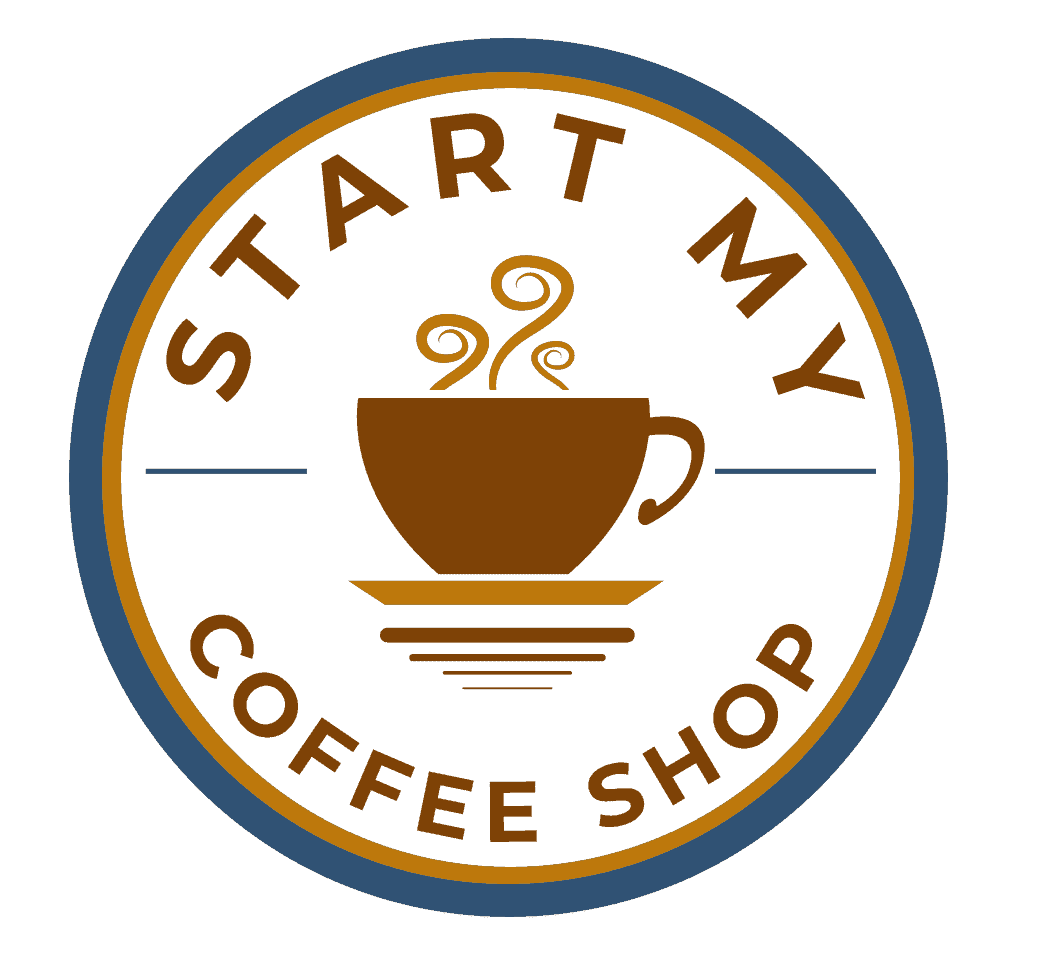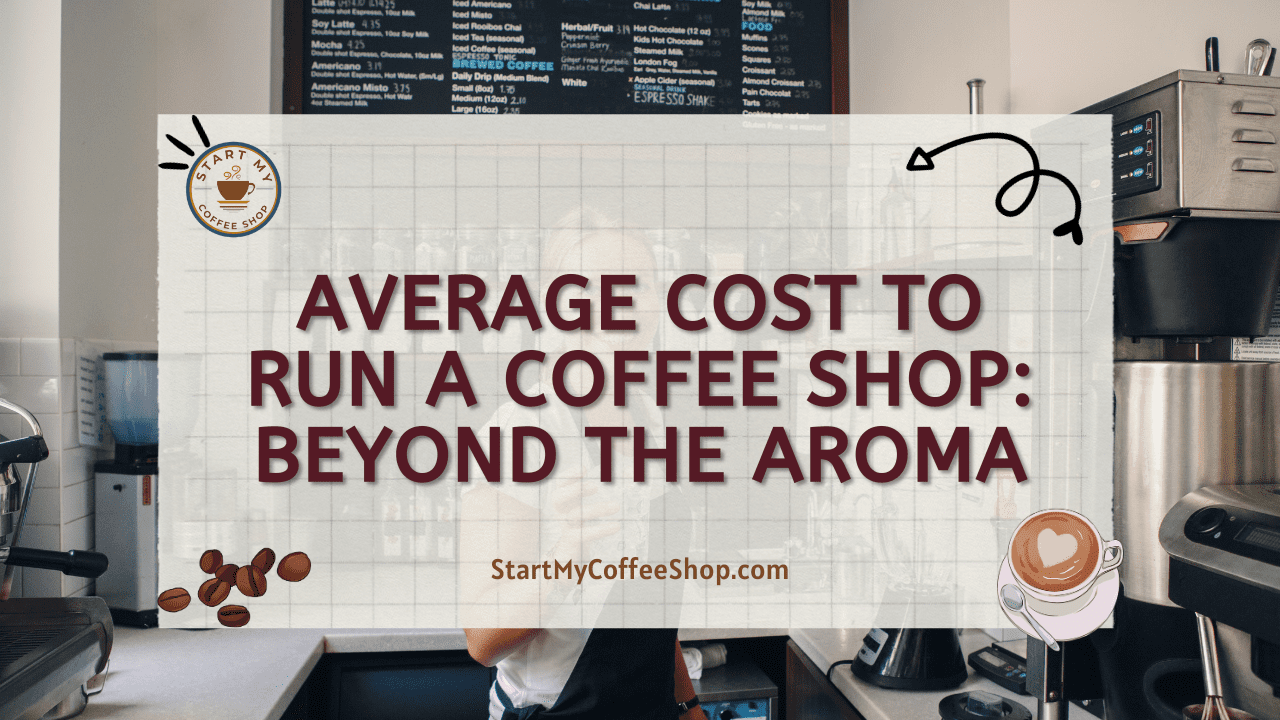Coffee shops have become a hub for socialization, work, and relaxation. For aspiring entrepreneurs, opening a coffee shop can be an exciting venture. However, before embarking on this caffeinated journey, it’s crucial to understand the average cost involved in running a coffee shop. Running a coffee shop entails various expenses like rent, equipment, inventory, staff wages, marketing, licenses, utilities, and overheads. Opening a coffee shop can range from a few thousand dollars to several hundred thousand dollars. So wise budgeting must be done. In this article, I will delve into the various expenses and factors that contribute to the overall cost, providing you with a comprehensive breakdown.
Location
 The cost of renting or purchasing a space for your coffee shop largely depends on where it is situated. Prime spots in bustling city centers often come with a premium price tag due to the high demand and potential customer traffic they offer. On the other hand, suburban areas might provide more affordable options. When selecting a location for your coffee shop, it is crucial to consider various factors. Foot traffic plays a vital role in the progress of your business. A location with a high volume of people passing by can increase your visibility and attract potential customers. Proximity to your target audience is another critical aspect to consider. If you are targeting a specific demographic, such as students or office workers, being close to their frequent hangouts or workplaces can be advantageous. Additionally, it’s important to assess the local competition in the area. Opening a coffee shop in an area saturated with similar establishments may pose challenges in terms of attracting customers and carving out your niche. On the other hand, being in an area with a limited number of coffee shops can offer a potential advantage. In prime city center locations, where demand is high, prices can soar into the thousands of dollars per month. On the contrary, suburban areas may provide more affordable options, with costs ranging from a few hundred to a couple of thousand dollars per month. Read more about: Best Five Locations To Start A Coffee Shop
The cost of renting or purchasing a space for your coffee shop largely depends on where it is situated. Prime spots in bustling city centers often come with a premium price tag due to the high demand and potential customer traffic they offer. On the other hand, suburban areas might provide more affordable options. When selecting a location for your coffee shop, it is crucial to consider various factors. Foot traffic plays a vital role in the progress of your business. A location with a high volume of people passing by can increase your visibility and attract potential customers. Proximity to your target audience is another critical aspect to consider. If you are targeting a specific demographic, such as students or office workers, being close to their frequent hangouts or workplaces can be advantageous. Additionally, it’s important to assess the local competition in the area. Opening a coffee shop in an area saturated with similar establishments may pose challenges in terms of attracting customers and carving out your niche. On the other hand, being in an area with a limited number of coffee shops can offer a potential advantage. In prime city center locations, where demand is high, prices can soar into the thousands of dollars per month. On the contrary, suburban areas may provide more affordable options, with costs ranging from a few hundred to a couple of thousand dollars per month. Read more about: Best Five Locations To Start A Coffee Shop
Equipment and Furnishings
The cost of equipment can vary depending on the size and scale of your coffee shop. For smaller establishments, the necessary equipment may cost a few thousand dollars. This typically includes a decent espresso machine, a grinder, a brewing system, and refrigeration units for storing milk and other perishable ingredients. As your coffee shop grows and expands, you may need to invest in more advanced equipment and larger capacity machines, which can drive the cost up to tens of thousands of dollars. In addition to coffee-making equipment, you’ll also need to budget for furnishings and decor to create an inviting atmosphere for your customers. This includes tables, chairs, countertops, display cases, and other furniture pieces. The cost of furnishing your coffee shop can vary depending on your desired aesthetic, the quality of the furniture, and any customization or branding elements you choose to incorporate. It’s important to consider the long-term benefits when investing in equipment and furnishings. Quality equipment not only ensures the production of consistent and delicious coffee but also reduces the likelihood of breakdowns and maintenance costs. Similarly, investing in durable and well-designed furniture can save you from frequent replacements and repairs.
Inventory and Supplies
 In the bustling world of coffee shops, the availability and quality of inventory play a vital role in maintaining customer satisfaction and operational achievement. Coffee beans, milk, syrups, pastries, and other supplies are the lifeblood of any coffee shop. Estimating the cost of inventory accurately is crucial for effective budgeting and financial planning. When considering the cost of inventory, several factors come into play. The variety and quality of coffee beans you choose to serve significantly impact the price. Specialty beans or unique blends may come at a higher cost than standard options. Additionally, the frequency of restocking is a crucial consideration. Understanding the demand for your products and establishing efficient supply chains are necessary to avoid shortages or excess inventory. Storage requirements are another aspect to consider. Properly storing coffee beans to maintain freshness and quality often involves investing in suitable containers or storage systems. Depending on the size and layout of your shop, you may need to allocate space and budget for refrigeration units or other specialized equipment. Beyond the core ingredients, it’s essential to account for various disposable items. Cups, lids, stirrers, napkins, and cleaning supplies are necessary for serving customers and maintaining hygiene standards. These items contribute to the overall cost of inventory and supplies. The cost of inventory can vary based on factors such as the size of your coffee shop, the breadth of your menu offerings, and any agreements with suppliers. Larger establishments with a wider range of products may require higher inventory investments to meet customer demands adequately. Developing relationships with reliable suppliers and negotiating favorable agreements can help mitigate inventory costs. By building strong partnerships, you may be able to secure competitive pricing or favorable payment terms.
In the bustling world of coffee shops, the availability and quality of inventory play a vital role in maintaining customer satisfaction and operational achievement. Coffee beans, milk, syrups, pastries, and other supplies are the lifeblood of any coffee shop. Estimating the cost of inventory accurately is crucial for effective budgeting and financial planning. When considering the cost of inventory, several factors come into play. The variety and quality of coffee beans you choose to serve significantly impact the price. Specialty beans or unique blends may come at a higher cost than standard options. Additionally, the frequency of restocking is a crucial consideration. Understanding the demand for your products and establishing efficient supply chains are necessary to avoid shortages or excess inventory. Storage requirements are another aspect to consider. Properly storing coffee beans to maintain freshness and quality often involves investing in suitable containers or storage systems. Depending on the size and layout of your shop, you may need to allocate space and budget for refrigeration units or other specialized equipment. Beyond the core ingredients, it’s essential to account for various disposable items. Cups, lids, stirrers, napkins, and cleaning supplies are necessary for serving customers and maintaining hygiene standards. These items contribute to the overall cost of inventory and supplies. The cost of inventory can vary based on factors such as the size of your coffee shop, the breadth of your menu offerings, and any agreements with suppliers. Larger establishments with a wider range of products may require higher inventory investments to meet customer demands adequately. Developing relationships with reliable suppliers and negotiating favorable agreements can help mitigate inventory costs. By building strong partnerships, you may be able to secure competitive pricing or favorable payment terms.
Staffing and Labor Costs
In the dynamic environment of a coffee shop, having a dedicated and skilled team of employees is essential for delivering excellent service and creating a positive customer experience. Labor costs, which encompass wages, benefits, and taxes, constitute a significant portion of the overall expenses. The number of employees required for your coffee shop depends on various factors. The size of your establishment, the hours of operation, and the projected volume of customers all play a role in determining staffing needs. A smaller coffee shop may require a lean team of baristas and servers, while a larger establishment with extended operating hours might necessitate additional staff members to manage the workload effectively. Apart from the cost of wages, it’s crucial to consider other aspects of labor expenses. Benefits such as healthcare coverage, retirement plans, and paid time off should be factored into the budget. Additionally, taxes, including payroll taxes and contributions to social security and Medicare, need to be accounted for. Training costs are another important consideration. Investing in thorough training programs ensures that your staff is equipped with the necessary skills in coffee preparation, customer service, and adherence to health and safety protocols. Training costs may include materials, specialized courses, or the time and expertise of experienced trainers. To optimize labor costs, it’s beneficial to implement efficient scheduling practices, ensuring that staffing levels align with peak customer demand while avoiding unnecessary overtime. Cross-training employees to handle multiple tasks can also enhance flexibility and productivity. Read more about: Average Cost of Opening a Coffee Stand: A Cup of Caffeine and Capital
Marketing and Advertising
Digital marketing has become increasingly important in today’s digital age. Investing in online advertising campaigns can help increase brand awareness and drive traffic to your coffee shop. This may include pay-per-click (PPC) advertising, search engine optimization (SEO), and social media advertising. Allocating funds for these digital marketing efforts ensure that your coffee shop is visible to potential customers who are actively seeking coffee-related information or nearby cafes. Social media management is also crucial for connecting with your target audience and fostering engagement. This may involve creating and curating content, managing social media accounts, and engaging with customers through comments and direct messages. Additionally, developing and maintaining an informative and visually appealing website is essential. Budgeting for website development and maintenance helps provide a professional online presence and enables customers to easily find information about your coffee shop, including location, menu, and hours of operation. Local advertising plays a significant role in attracting customers from your immediate community. This may include advertising in local newspapers, magazines, or community websites. Collaborating with influencers or local organizations can also be an effective way to generate buzz and increase foot traffic to your coffee shop. Hosting events, such as coffee tastings, live music performances, or art exhibits, can create a unique and memorable experience for customers while promoting your brand. The costs associated with marketing efforts will vary depending on the scale and reach of your campaigns. It’s crucial to allocate a portion of your budget to marketing to ensure that you effectively spread the word about your coffee shop and reach your target audience.
Licenses, Permits, and Insurance
Acquiring the necessary permits and licenses is essential to meet regulatory standards and operate your coffee shop legally. These may include permits for food handling, health inspections, signage, and outdoor seating, if applicable. Each jurisdiction may have specific requirements, so it’s important to research and obtain the appropriate permits to avoid potential fines or closure. Insurance coverage is another crucial aspect to consider. Protecting your coffee shop from unforeseen circumstances and potential lawsuits is vital for long-term sustainability. Liability insurance safeguards your business in case of accidents, injuries, or claims related to your coffee shop’s operations. Property insurance covers damage or loss to your physical assets, such as equipment, furniture, and inventory. The cost of insurance premiums may vary based on factors like the size of your coffee shop, location, and coverage limits. Working with insurance professionals who specialize in the food and beverage industry can help you tailor insurance policies to your specific needs and ensure adequate coverage. It’s important to review and update your insurance policies regularly to stay protected against evolving risks and changes in your business.
Utilities and Overhead Expenses
Utilities, such as electricity, water, and internet service, are essential for the day-to-day functioning of your coffee shop. Lighting, heating or cooling systems, and powering coffee-making equipment all contribute to your electricity usage. Water is needed for brewing coffee, cleaning, and maintaining hygiene standards. Additionally, a reliable internet connection is necessary for processing transactions, managing online orders, and engaging with customers through social media. In addition to utilities, there are various overhead expenses to consider. Renter’s insurance protects your business against potential property damage or liability claims. Waste management services ensure proper disposal of trash and recyclables, maintain cleanliness, and meet environmental regulations. Pest control measures help prevent and address any pest-related issues that could compromise hygiene and customer satisfaction. Equipment maintenance is also essential to keep your coffee-making equipment in optimal working condition, reducing the risk of breakdowns and ensuring consistent quality. Budgeting for these recurring expenses is crucial for the financial health of your coffee shop. By accurately estimating and accounting for these ongoing costs, you can effectively manage your cash flow and ensure that your coffee shop remains operational without any disruptions. Furthermore, it’s important to regularly review and evaluate these expenses to identify potential areas for cost-saving or efficiency improvements. For instance, you can explore energy-saving initiatives to reduce electricity consumption, negotiate favorable terms with service providers, or implement preventive maintenance schedules to prolong the lifespan of your equipment. Read more about: How Much Does It Cost To Open Up A Coffee Shop: Opening Expenses Revealed
Summary
 Running a coffee shop requires careful financial planning and a comprehensive understanding of the costs involved. From location selection to equipment purchases, inventory management to staffing, and marketing to overhead expenses, each aspect contributes to the overall cost of operating a great coffee shop. By analyzing these factors and creating a detailed budget, aspiring coffee shop owners can embark on their entrepreneurial journey with confidence and a better understanding of the average cost to run a coffee shop.
Running a coffee shop requires careful financial planning and a comprehensive understanding of the costs involved. From location selection to equipment purchases, inventory management to staffing, and marketing to overhead expenses, each aspect contributes to the overall cost of operating a great coffee shop. By analyzing these factors and creating a detailed budget, aspiring coffee shop owners can embark on their entrepreneurial journey with confidence and a better understanding of the average cost to run a coffee shop.
Frequently Asked Questions
Q: What are the ongoing expenses of running a coffee shop?
A: Ongoing expenses include rent, utilities, payroll, inventory replenishment, marketing, equipment maintenance, licenses, permits, insurance, and general overhead costs.
Q: How much should I budget for coffee shop equipment?
A: Generally, you should budget anywhere from $10,000 to $50,000 or more for essential coffee-making equipment.
Q: What are the typical staffing costs for a coffee shop?
A: On average, staffing costs can account for 25-35% of total expenses.
To learn more on how to start your own coffee shop, check out my startup documents here.
Disclaimer: The information provided by StartMyCoffeeShop.com (“The Site”) is for general informational purposes only. All information on the Site is provided in good faith. However, we make no representation or warranty of any kind, express or implied, regarding the accuracy, adequacy, validity, reliability, availability, or completeness of any information on the Site. Under no circumstance shall we have any liability to you for any loss or damage of any kind incurred as a result of the use of the Site or Reliance on any information provided on the Site. Your use of the Site and reliance on any information on the Site is solely at your own risk. This blog post is for educational purposes only and does not constitute legal advice. Please consult a legal expert to address your specific needs. Terms and Conditions. (https://startmycoffeeshop.com/terms-and-conditions/)

Hi! I’m Shawn Chun
My adventure in coffee began when I first launched my first coffee shop back in the early 2000s. I had to figure out so many things on my own and to make it worse within 2 years of opening two large corporate coffee chains moved in just blocks away from me!
As I saw smaller and even some larger coffee shops in the neighborhood slowly lose customers to these giant coffee chains and slowly close up shop, I knew that I had to start getting creative…or go out of business.
I (like you may be) knew the coffee industry well. I could make the best latte art around and the foam on my caps was the fluffiest you have ever seen. I even had the best state-of-the-art 2 group digital Nuova Simonelli machine money could buy. But I knew that these things alone would not be enough to lure customers away from the name brand established coffee shops.
Eventually, through lots of trial and error as well as perseverance and creativity I did find a way to not only survive but also thrive in the coffee/espresso industry even while those corporate coffee chains stayed put. During those years I learned to adapt and always faced new challenges. It was not always easy, however, in the end, I was the sole survivor independent coffee shop within a 10-mile radius of my location. Just two corporate coffee chains and I were left after that year. All told the corporate coffee chains took down over 15 small independent coffee shops and kiosks and I was the last one standing and thriving.
Along the years I meet others with the same passion for coffee and I quickly learned that it is not only “how good a barista is” that makes a coffee shop successful, but the business side of coffee as well.
Hence why I started this website you are on now. To provide the tools and resources for up and coming coffee shop owners to gain that vital insight and knowledge on how to start a coffee shop successfully.
Stick around, browse through my helpful blog and resources and enjoy your stay! With lots of LATTE LOVE!
Shawn






